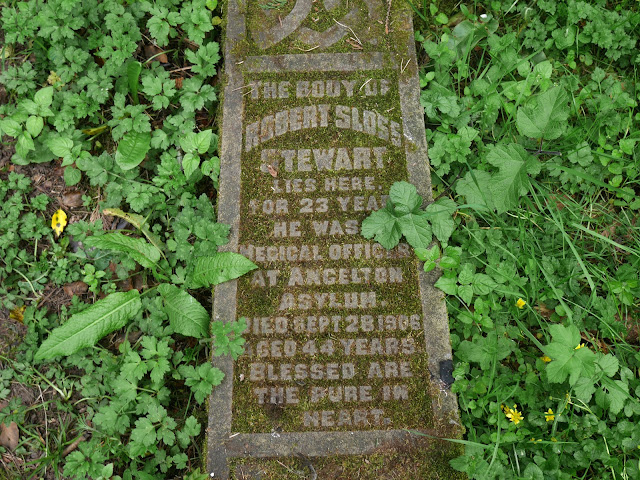 |
| The tipped gravestone of Dr. Robert Sloss Stewart. |
Hidden in the overgrown woodland next to Glanrhyd Hospital, lies the remains of the original Angelton Asylum Cemetery. Although hundreds of people are buried there, only ten gravestones remain. (Between 1915 - 1926, 288 people were buried at the hospital cemetery)
While researching the stories of the people buried there, I came across an interesting gentleman named Dr. Robert Sloss Stewart. Unfortunately not much is known about Robert's life. What little we know has been drawn from census records, medical journals, and newspaper articles.
Robert Sloss Stewart was born to Matthew and Catherine Stewart (nee Ritchie) on the 20th of January 1862, in Dalmellington, Scotland.
- The 1871 Census shows Robert aged 8, living at home with his parents and three siblings.
- The 1881 Census tells us that Robert was a student of medicine and was lodging with the Peters family in Partick, Scotland.
 |
| An extract from the Medical Register of 1891. |
The register also details the qualifications obtained by Dr Stewart:
- M.B Master Surgeon - 1883.
- MD at University Of Glasgow - 1886.
- Dip. Public Health at University of Cambridge - 1887.
Subsequently, Dr. Stewart gained the position of Assistant Medical Officer at Angelton Asylum.
At this time Dr. Stewart was given a wage of £800 per year. This also included amenities: House, Coal, Gas, Laundry, Garden Produce, Groom, Hay and Straw for two horses.
The 1891 Census shows Dr. Stewart, aged 29 is listed as living at and working as the First Attendant of Angelton Asylum. By 1901, Dr. Stewart had become Deputy Medical Superintendent of Angelton Asylum.
 |
| Dr. Stewart was appointed Medical Superintendent imminently on the retirement of Dr. Henry Pringle in February 1904. |
Throughout his medical career, Dr. Stewart became well-known for his papers and theories on the subject of mental health. His papers include:
- Observations of the Spinal Cord of the Insane – 1886
- Ataxic Paraplegia in Case of Primary Dementia - 1887
- The Spastic and Tabetic types of General Paralysis - 1895
- The Increase of General Paralysis in England and Wales – 1896
- Decrease of General Paralysis of the Insane in England and Wales – 1901
- The Relationship of Wages, Lunacy, and Crime in South Wales - 1904
- The Mental and Moral Effects of the South African War (1889 – 1902) on the British People - 1904.
Regularly giving lectures at Cardiff College, he was keenly interested in his fellow man, he made close studies of conditions in the county of Glamorgan and took a keen interest in the connection between social factors and 'lunacy'.
Dr. Stewart's paper 'The Mental and Moral Effects of the South African War' "attracted some amount of attention from those interested in social problems, the conclusions at which he arrived being that the impressions produced by the events of the last three months of the year 1899 were such as to induce a very unmistakable change in the national characteristics..."
| Dr Stewart was admitted into the Prince Llewellyn Lodge of the Freemasons at Cardiff in April 1886. |
On the 1st of August 1905, Dr. Stewart married Helen Greener at Kingshill, Scotland. Also a medical professional, Helen was born in Scotland during 1874.
In November 1905, The Glamorgan Gazette reported that Dr Stewart is suffering from a serious illness, so serious that Sir William Broadbent of London was called to the County Asylum at Angelton. It is reported that Dr Stewart was suffering from a haemorrhage of the lung.
On the 28th of September 1906, Dr Robert Sloss Steward died at his residence in Angelton Asylum as a result of heart failure. It is thought that this was brought on by the haemorrhage he suffered less than a year before his death.
On his death, obituaries appeared in various medical journals including The Lancet, The American Journal of Psychiatry, the Glasgow Medical Journal and The British Journal of Psychiatry.
The British Journal of Psychiatry writes:
Dr Stewart's funeral took place at Angelton Asylum on the 1st of October 1906. It was semi-private and the service was conducted by Rev. David Davies of Canton and Rev. R.J. Jones (Asylum Chaplain). Dr Stewart was then interred in the cemetery adjoining Angelton Asylum. Among those who attended were his widow Mrs Stewart, Alderman Richard Lewis (Pontypridd) Alderman John Thomas (Tondu) Dr Finlay, Dr Paterson, Rev. W.S. Evans and Rev. W. Evanson.
(Sources: BJPsych - The Glamorgan Gazette - WelshNewspapersOnline - Medical Register 1891)
On the 28th of September 1906, Dr Robert Sloss Steward died at his residence in Angelton Asylum as a result of heart failure. It is thought that this was brought on by the haemorrhage he suffered less than a year before his death.
On his death, obituaries appeared in various medical journals including The Lancet, The American Journal of Psychiatry, the Glasgow Medical Journal and The British Journal of Psychiatry.
The British Journal of Psychiatry writes:
"By Dr. Stewart's untimely death, Glamorgan Asylum has lost an able Superintendent and the medical profession a prominent member. Of a retiring, unostentatious, kind, genial disposition, he was universally respected and esteemed and his loss is keenly felt by all who knew him."
 |
| The original Angelton Asylum. Chapel - now Glanrhyd Hospital Chapel |
 |
| The tipped gravestone of Dr. Robert Sloss Stewart. |

No comments
Post a Comment
Note: only a member of this blog may post a comment.